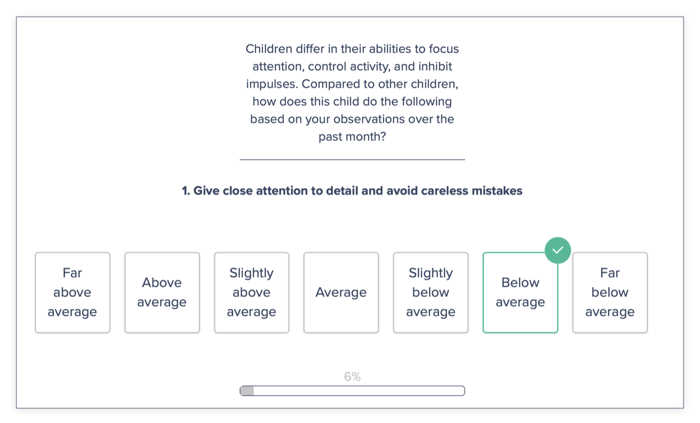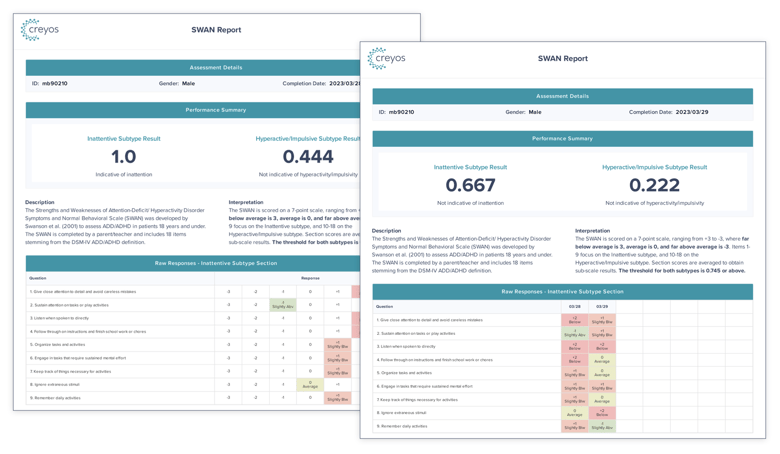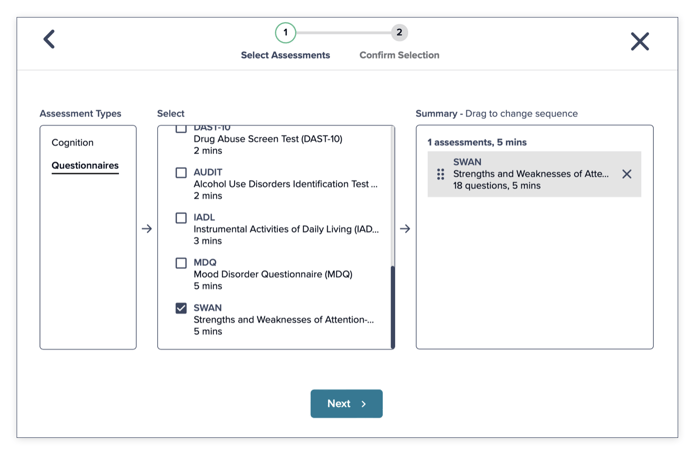
Measure ADHD Symptoms in Children Under 18 With the SWAN
Published: 31/03/2023
Written by: Mike Battista
Almost 1 in 10 children will be diagnosed with attention-deficit/hyperactivity disorder, according to the CDC, resulting in challenges for many children and their families. Healthcare providers who work with children often encounter ADHD, whether it is the main focus of treatment or not, so a simple instrument for measuring attentional problems is invaluable in nearly any practice.
The Strengths and Weaknesses of Attention-Deficit/Hyperactivity Symptoms and Normal Behavior Scale (SWAN) was developed as a screening instrument for ADHD in children and adolescents under age 18. It is designed to capture a range of positive, negative, and normal behaviors rather than only focusing on rare extreme symptoms of attentional disorders—hence the unwieldy name. The SWAN is completed by a parent/guardian or teacher and includes 18 items asking them to compare attention-related skills to other children the same age.
Note: The purpose of the SWAN is to assist the clinician in determining whether the individual is exhibiting symptoms that may be consistent with ADHD, and monitoring the severity of these symptoms over time. However, it is not a standalone diagnostic tool. Any conclusions drawn from the SWAN should be paired with clinical interviews and observations, other mental health examinations or assessments administered, and other evaluations of the patient and/or the patient's family history.
What is the SWAN?
The SWAN was developed by Swanson and colleagues (2015) to assess ADHD symptoms in clinical and non-clinical populations.
The SWAN includes a set of 18 questions that stem from the definition of ADD/ADHD outlined in the DSM-IV. A child’s behavior is scored on a 7-point scale ranging from far above average to far below average, with 4 (average) representing normal behavior for the child’s age

This approach—comparing both positively and negatively to average children—helps minimize social-cultural and statistical biases. It also addresses the full range of strengths and weaknesses in attention-related behaviors, rather than only categorical classifications and pathological symptoms. Swanson’s team had previously created the SNAP-IV scale, but iterated on it to measure nuances in the severity of symptoms, resulting in the SWAN as an improved ADHD assessment tool.
Items 1 to 9 are associated with inattentive ADHD and items 10 to 18 are associated with hyperactive/impulsive ADHD. Scores are established by averaging scores in each subscale, then comparing the scores to research-based cutoff scores. Cutoff scores for each subtype were derived by averaging the results of multiple studies that determined cutoffs for optimal sensitivity and specificity for identifying patients with ADHD in clinical and community samples (Robaey et al., 2007; Chan et al., 2014; Alhaji, 2022). An average score above 0.745 on items 1-9 is indicative of inattentive ADD/ADHD, and (by coincidence) an average score above 0.745 on items 10-18 is indicative of the hyperactive/impulsive ADD/ADHD. Note that classifications are based on cutoff scores for parent ratings. Interpret reports based on teacher ratings with caution.

In studies establishing cutoff scores, the SWAN generally demonstrates high sensitivity for ADHD (82%+), but specificity varies depending on the study and population. False positive results (i.e., finding a score indicative of ADHD in a person who would not be diagnosed with ADHD by an expert) are possible, especially in clinical populations with comorbidities and diverse medical histories, or when ADHD is not necessarily suspected. Always follow up with objective cognitive testing, patient / guardian interviews, and most importantly, expert clinical judgment.
How can healthcare providers make the most out of administering the SWAN to patients?
Any healthcare provider who works with children may benefit from monitoring signs of ADHD. Even if ADHD is not a practice’s primary focus, attentional difficulties can be at least partially responsible for a variety of struggles that cause a parent to seek treatment, such as academic or social difficulties. A quick symptom inventory like the SWAN can help quantify, verify, or rule out attentional issues.
Clinical psychologists, psychiatrists, neurologists, and other healthcare providers working with young patients may find value in administering the SWAN alongside Creyos Health cognitive assessments to gain a fuller picture of a child’s mental and cognitive health. As a diagnostic aid, cognitive performance scores can complement ADHD scales like the SWAN, verifying reported symptoms with objective data, providing additional details on the specific cognitive domains affected, or ruling out broader cognitive impairment. As treatment progresses, many providers will administer additional assessments in order to verify that treatments are not only moving patients away from the thresholds on the SWAN, but also showing up in objective cognitive measures.
How is ADHD related to cognition?
Children diagnosed with ADHD often demonstrate differences not only on parent-reported scales, but on objective tests of cognition.
For example, one study (Crosbie et al., 2013) asked parents in a public setting to fill out the SWAN while their children completed a stop signal cognitive task (similar to the Creyos SART) meant to measure aspects of attention, such as response inhibition. Parent SWAN scores were correlated with objectively-measured ability to inhibit responses, speed of responses, and variability of responses. The correlation between reported ADHD symptoms and behavioral measures was strong, and it did not depend on age or gender. There were even shared genetic contributors to reaction time and SWAN scores.
ADHD is linked to several cognitive domains. Areas such as working memory (measured by Token Search in Creyos Health), planning (measured by Spatial Planning), and of course short-term attention itself (measured by Double Trouble and Feature Match) may be of particular interest to clinicians treating ADHD, and have been shown to be impaired in children diagnosed with ADHD (see Castellanos & Tannock, 2002).
When treating ADHD, cognition has been used as a key outcome measure to measure progress and adjust intervention plans. In a study looking at children enrolled in a behavioral program for treating attentional issues, Creyos Health measures of cognition improved more than in a control group (Jackson & Wild, 2021), and the cognitive reports have been used to objectively demonstrate progress to parents.
For medication-based treatments such as methylphenidate, objective cognitive measures complement parent rating forms to help determine proper dosages and measure progress. In fact, cognition may mediate the effects of medication on behavioral outcomes—that is, medication improves cognition, which goes on to improve everyday symptoms of ADHD (see Hawk et al., 2018). Measuring cognition may also be beneficial for long-term follow up with ADHD patients, as maturation of cognitive function can predict ADHD remission (Halperin et al., 2008; Karalunas et al., 2017).
ADHD is a complex condition. Healthcare providers can benefit from administering both observer rating scales (like the SWAN) and objective cognitive testing (like the Creyos cognitive tasks) to fully measure and address a child’s symptoms.
How to administer a computerized version of the SWAN in Creyos Health
The Creyos version of the SWAN is scored automatically and offered in English, Spanish, and French. Note that Creyos Health also includes the Adult Self Report Scale (ASRS) for measuring adult ADHD, and the Vanderbilt ADHD Diagnostic Rating Scale (VADRS) as an additional choice for assessing ADHD in children age 6 to 12.
It is easy for clinicians using Creyos Health to include the SWAN in an assessment protocol. The scale can be sent on its own, or alongside a series of cognitive tasks. When creating a protocol in Creyos Health, click the Questionnaires section, then check off the SWAN. You can check off tasks from the Cognitive Assessments section for an integrated flow. Remember, the Creyos version of the SWAN is designed for a parent or guardian to complete, so it may require a heads-up to pass the device to the child when it is time to complete the cognitive assessment portion of the protocol.

For detailed instructions on administering questionnaires within Creyos Health, please see our previous blog post on administering a digital PHQ-9.
The version of the SWAN included in Creyos Health is fully web-based, so the questionnaire can be administered to parents in-clinic or at home, on any device, and requires no special training. The scale can also be added to a Creyos Health schedule, allowing you to automatically send it via email at predefined times. The results are scored instantly, and if completed more than once, results are added to the patient’s report to track changes due to treatments or monitor for variations. For parents, completing the SWAN takes about five minutes and no registration or login are required. With minimal effort, you as the healthcare provider, children, teachers, and parents all benefit from the valuable information provided by a standardized, validated measure of ADHD symptoms.
Need more computerized health screeners and checklists?
Creyos Health includes many mental health screeners and patient questionnaires. If there are other questionnaires you would like included in Creyos Health, such as those you currently administer in pen-and-paper form, please do not hesitate to let us know by commenting on this blog post or contacting us directly by email. We are always happy to hear your feedback.
As always, thank you,
— Mike, Staff Scientist at Creyos, and the Creyos team
